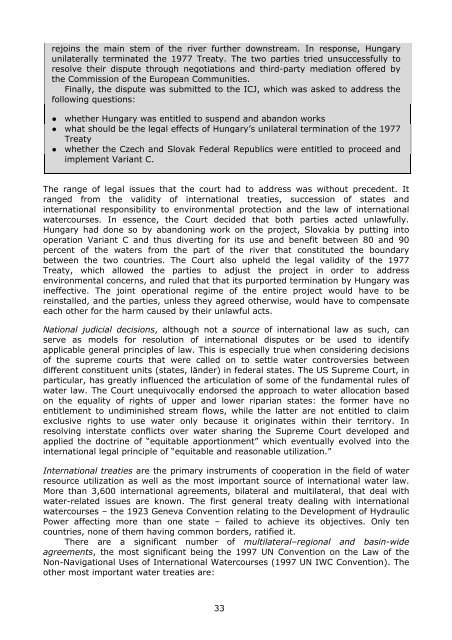Water security and peace: a synthesis of studies ... - unesdoc - Unesco
Water security and peace: a synthesis of studies ... - unesdoc - Unesco
Water security and peace: a synthesis of studies ... - unesdoc - Unesco
Create successful ePaper yourself
Turn your PDF publications into a flip-book with our unique Google optimized e-Paper software.
ejoins the main stem <strong>of</strong> the river further downstream. In response, Hungary<br />
unilaterally terminated the 1977 Treaty. The two parties tried unsuccessfully to<br />
resolve their dispute through negotiations <strong>and</strong> third-party mediation <strong>of</strong>fered by<br />
the Commission <strong>of</strong> the European Communities.<br />
Finally, the dispute was submitted to the ICJ, which was asked to address the<br />
following questions:<br />
! whether Hungary was entitled to suspend <strong>and</strong> ab<strong>and</strong>on works<br />
! what should be the legal effects <strong>of</strong> Hungary’s unilateral termination <strong>of</strong> the 1977<br />
Treaty<br />
! whether the Czech <strong>and</strong> Slovak Federal Republics were entitled to proceed <strong>and</strong><br />
implement Variant C.<br />
The range <strong>of</strong> legal issues that the court had to address was without precedent. It<br />
ranged from the validity <strong>of</strong> international treaties, succession <strong>of</strong> states <strong>and</strong><br />
international responsibility to environmental protection <strong>and</strong> the law <strong>of</strong> international<br />
watercourses. In essence, the Court decided that both parties acted unlawfully.<br />
Hungary had done so by ab<strong>and</strong>oning work on the project, Slovakia by putting into<br />
operation Variant C <strong>and</strong> thus diverting for its use <strong>and</strong> benefit between 80 <strong>and</strong> 90<br />
percent <strong>of</strong> the waters from the part <strong>of</strong> the river that constituted the boundary<br />
between the two countries. The Court also upheld the legal validity <strong>of</strong> the 1977<br />
Treaty, which allowed the parties to adjust the project in order to address<br />
environmental concerns, <strong>and</strong> ruled that that its purported termination by Hungary was<br />
ineffective. The joint operational regime <strong>of</strong> the entire project would have to be<br />
reinstalled, <strong>and</strong> the parties, unless they agreed otherwise, would have to compensate<br />
each other for the harm caused by their unlawful acts.<br />
National judicial decisions, although not a source <strong>of</strong> international law as such, can<br />
serve as models for resolution <strong>of</strong> international disputes or be used to identify<br />
applicable general principles <strong>of</strong> law. This is especially true when considering decisions<br />
<strong>of</strong> the supreme courts that were called on to settle water controversies between<br />
different constituent units (states, länder) in federal states. The US Supreme Court, in<br />
particular, has greatly influenced the articulation <strong>of</strong> some <strong>of</strong> the fundamental rules <strong>of</strong><br />
water law. The Court unequivocally endorsed the approach to water allocation based<br />
on the equality <strong>of</strong> rights <strong>of</strong> upper <strong>and</strong> lower riparian states: the former have no<br />
entitlement to undiminished stream flows, while the latter are not entitled to claim<br />
exclusive rights to use water only because it originates within their territory. In<br />
resolving interstate conflicts over water sharing the Supreme Court developed <strong>and</strong><br />
applied the doctrine <strong>of</strong> “equitable apportionment” which eventually evolved into the<br />
international legal principle <strong>of</strong> “equitable <strong>and</strong> reasonable utilization.”<br />
International treaties are the primary instruments <strong>of</strong> cooperation in the field <strong>of</strong> water<br />
resource utilization as well as the most important source <strong>of</strong> international water law.<br />
More than 3,600 international agreements, bilateral <strong>and</strong> multilateral, that deal with<br />
water-related issues are known. The first general treaty dealing with international<br />
watercourses – the 1923 Geneva Convention relating to the Development <strong>of</strong> Hydraulic<br />
Power affecting more than one state – failed to achieve its objectives. Only ten<br />
countries, none <strong>of</strong> them having common borders, ratified it.<br />
There are a significant number <strong>of</strong> multilateral–regional <strong>and</strong> basin-wide<br />
agreements, the most significant being the 1997 UN Convention on the Law <strong>of</strong> the<br />
Non-Navigational Uses <strong>of</strong> International <strong>Water</strong>courses (1997 UN IWC Convention). The<br />
other most important water treaties are:<br />
33
















